With so many wonderful selections of children's and young adult literature published this fall, members of the Children's Literature and Special Interest Group wanted to share titles that really stand out for their unique content, presentation, or timeliness. Some of the books are by renowned authors breaking out of the typical style or genre. Some feature little known stories or diverse perspectives on well-known figures.
As you read aloud, plan reading workshop, literature circles and book talks for independent reading, you will want to consider the variety of themes and formats that are bound to intrigue the readers in your class.
Grades K-2
Dubuc, Marianne. (2014). Lion and the Bird. New York, NY: Enchanted Lion Books.
 This international offering uses multiple wordless pages to capture the friendship between and a lion and a bird. The textured illustrations use greens, blues, grays, and a lot of white space to convey the tone of the story as it fluctuates from camaraderie to loneliness. The pacing of the plot is carefully executed through variation in page layout, especially during the winter the lion and the bird spend together. Young readers will delight in figuring out the unspoken parts of this narrative and in noticing small details in the illustrations. This title will pair nicely with other books about seasonal changes and unusual animal friendships, but stands out for its subtle imagery, unique characters, and quiet charm.
This international offering uses multiple wordless pages to capture the friendship between and a lion and a bird. The textured illustrations use greens, blues, grays, and a lot of white space to convey the tone of the story as it fluctuates from camaraderie to loneliness. The pacing of the plot is carefully executed through variation in page layout, especially during the winter the lion and the bird spend together. Young readers will delight in figuring out the unspoken parts of this narrative and in noticing small details in the illustrations. This title will pair nicely with other books about seasonal changes and unusual animal friendships, but stands out for its subtle imagery, unique characters, and quiet charm.
— Lesley Colabucci, Millersville University of Pennsylvania.
Appelt, Kathi (2014) Mogi: The Heart of the House. Illus by Marc Rosenthal. New York, NY: Antheneum Books for Young Readers.
 Featuring playful illustrations and repetitive text, this picture book will appeal to adults and children alike. Adults, like the author herself, will be charmed by the real story of Mogi, the dog who cheers up patients at the Ronald McDonald House. Children may not exactly understand the nature of the hospital or its role in the children’s lives, but they will delight in the cartoon style art which contains plenty of silly details, the catchy phrasing, and the overall hopeful tone. Readers get to know two specific children, Gage and Antonia, but the book offers parents and teachers a great opportunity to talk in much more depth about children like these two.
Featuring playful illustrations and repetitive text, this picture book will appeal to adults and children alike. Adults, like the author herself, will be charmed by the real story of Mogi, the dog who cheers up patients at the Ronald McDonald House. Children may not exactly understand the nature of the hospital or its role in the children’s lives, but they will delight in the cartoon style art which contains plenty of silly details, the catchy phrasing, and the overall hopeful tone. Readers get to know two specific children, Gage and Antonia, but the book offers parents and teachers a great opportunity to talk in much more depth about children like these two.
—Lesley Colabucci, Millersville University of Pennsylvania
Alexander, Rilla. (2014). The Best Book in the World. London, UK: Flying Eye Books.
 What makes a book the best in the world? Well, designer/illustrator, Rilla Alexander’s visually stunning picture book provides the universal answer: each book leads the reader to imagine endless possibilities. Each page is an invitation to encourage reading. Within the pages of this inventive book, there are images of a little girl immersed in reading (at the kitchen table, on the bus, at the airport, at the amusement park, etc.). The title page offers a shadow image of a house, where the little girl steps outside, book in hand, ready to start her adventure. Each page alternates hues of colors, with the focus on the little girl (and her book) pictured in red. No matter what book you decide to read or where you decide to read it, a story will take you to a magical and unexpected journey. The sparse text will ignite further conversation about the illustrations. Each page offers a glimpse into the imaginary world, its characters, settings, and possibilities offered by reading a book. The dramatic shift in size, perspective, and colors tell their own story. Readers will want to carefully observe how the little girl is slowly, slowly ending her busy day by drifting off to sleep. The two page spread of the little girl dreaming inside the book’s pages simply capture the beauty of its message: A good story will stay with you, help you dream about possibilities, and offer new understandings about the world.
What makes a book the best in the world? Well, designer/illustrator, Rilla Alexander’s visually stunning picture book provides the universal answer: each book leads the reader to imagine endless possibilities. Each page is an invitation to encourage reading. Within the pages of this inventive book, there are images of a little girl immersed in reading (at the kitchen table, on the bus, at the airport, at the amusement park, etc.). The title page offers a shadow image of a house, where the little girl steps outside, book in hand, ready to start her adventure. Each page alternates hues of colors, with the focus on the little girl (and her book) pictured in red. No matter what book you decide to read or where you decide to read it, a story will take you to a magical and unexpected journey. The sparse text will ignite further conversation about the illustrations. Each page offers a glimpse into the imaginary world, its characters, settings, and possibilities offered by reading a book. The dramatic shift in size, perspective, and colors tell their own story. Readers will want to carefully observe how the little girl is slowly, slowly ending her busy day by drifting off to sleep. The two page spread of the little girl dreaming inside the book’s pages simply capture the beauty of its message: A good story will stay with you, help you dream about possibilities, and offer new understandings about the world.
—Mary Napoli, Penn State Harrisburg
Browne, Anthony. (2014). What if ...? Somerville, MA: Candlewick Press.
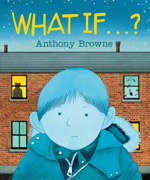 Anthony Browne presents another visual feast to capture a readers’ imagination. Teachers might wish to share the video clip featuring Browne reading the first several pages of his new book to pique curiosity. The story begins with an image of Joe clutching a birthday present for his friend Tom. Unfortunately, Joe lost the invitation to Tom’s birthday party and didn’t know the address. Joe’s mom reassures him that they will find Tom’s house together. Joe worries about whether he would know anyone at the party or if he would like the food. Throughout the story, his mom reassures him. As they walk through their neighborhood, they stop at several homes to look inside. Each window shaped frame features interesting and unusual characters which heighten Joe’s anxiety about the party. When, they finally reach Tom’s house, his mother hopes that her son will have a good time despite his fears. When it was time to go home, Joe’s mom is thrilled to know that he did in fact have a splendid time. Anthony Browne effectively employs word-and-image interactions by playing with hues and metafictive elements. He captures the emotional complexity of a child’s world by presenting a captivating story. He also alternates small and large frames throughout and includes speech bubbles to capture the conversation between mother and son. Teachers will want to encourage readers to look closely at the images and to share their observations.
Anthony Browne presents another visual feast to capture a readers’ imagination. Teachers might wish to share the video clip featuring Browne reading the first several pages of his new book to pique curiosity. The story begins with an image of Joe clutching a birthday present for his friend Tom. Unfortunately, Joe lost the invitation to Tom’s birthday party and didn’t know the address. Joe’s mom reassures him that they will find Tom’s house together. Joe worries about whether he would know anyone at the party or if he would like the food. Throughout the story, his mom reassures him. As they walk through their neighborhood, they stop at several homes to look inside. Each window shaped frame features interesting and unusual characters which heighten Joe’s anxiety about the party. When, they finally reach Tom’s house, his mother hopes that her son will have a good time despite his fears. When it was time to go home, Joe’s mom is thrilled to know that he did in fact have a splendid time. Anthony Browne effectively employs word-and-image interactions by playing with hues and metafictive elements. He captures the emotional complexity of a child’s world by presenting a captivating story. He also alternates small and large frames throughout and includes speech bubbles to capture the conversation between mother and son. Teachers will want to encourage readers to look closely at the images and to share their observations.
—Mary Napoli, Penn State Harrisburg
Grades 3-5
Rosenstock, Barb (2014). Ben Franklin’s Big Splash: The Mostly True Story of His First Invention. Illus by S.D. Schindler. Honesdale, PA: Calkins Creek (Boyds Mills Press).
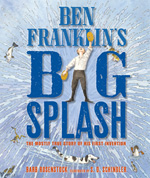 In this clever book, readers are introduced to a young Ben Franklin. While there are many biographies of this American icon, this one offers new information in an inviting style. The story starts on the title page which shows “Ben” landing a cannonball jump, splashing amongst fish and frogs. The joy on his face is reinforced throughout the text and pictures as reader learn of Franklin’s passion for swimming from a young age. The story of Franklin’s attempt to swim more like a fish creates a portrait of Franklin that models perseverance without any heavy-handedness. The narrative text features poetic language, the typography changes to show emphasis, and the page layout varies to help delineate the plot. The book ends with examples of Franklin “solving BIG problems” later in life, such as inventing bifocals and designing US coins. An authors’ note, timeline, and source notes are included.
In this clever book, readers are introduced to a young Ben Franklin. While there are many biographies of this American icon, this one offers new information in an inviting style. The story starts on the title page which shows “Ben” landing a cannonball jump, splashing amongst fish and frogs. The joy on his face is reinforced throughout the text and pictures as reader learn of Franklin’s passion for swimming from a young age. The story of Franklin’s attempt to swim more like a fish creates a portrait of Franklin that models perseverance without any heavy-handedness. The narrative text features poetic language, the typography changes to show emphasis, and the page layout varies to help delineate the plot. The book ends with examples of Franklin “solving BIG problems” later in life, such as inventing bifocals and designing US coins. An authors’ note, timeline, and source notes are included.
— Lesley Colabucci, Millersville University of Pennsylvania
Rubin, Susan Goldman. (2014). Stand There! She Shouted: The Invincible Photographer Julia Margaret Cameron. Illus.by Bagram Ibatoulline. Somerville, MA: Candlewick Press.
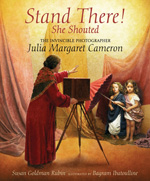 This extraordinary biography includes information about the Victorian photographer, Julia Margaret Cameron. A mixture of gorgeous illustrations with reproductions of photographs captures the essence of beauty that distinguished Cameron’s work. Told in an accessible style, readers will learn about Cameron’s early life, interest in photography, and her professional success. Each page contains a “period trim” coupled by sketches and realistic images portraying Cameron’s life. Goldman’s impeccable research includes quotes from Cameron’s models, including those of her relatives. Though Cameron’s models often feared her and the lengthy hours of sitting or standing still, the results of the images captured the beauty of the world, the innocence of simple emotions, and a unique perspective. Cameron’s work was not immediately appreciated by her critics, but her perseverance led to her success. Goldman includes information about the earliest experimentations with photography. Also included are extensive bibliographic notes as well as a list of museums where readers can find Cameron’s photographs.
This extraordinary biography includes information about the Victorian photographer, Julia Margaret Cameron. A mixture of gorgeous illustrations with reproductions of photographs captures the essence of beauty that distinguished Cameron’s work. Told in an accessible style, readers will learn about Cameron’s early life, interest in photography, and her professional success. Each page contains a “period trim” coupled by sketches and realistic images portraying Cameron’s life. Goldman’s impeccable research includes quotes from Cameron’s models, including those of her relatives. Though Cameron’s models often feared her and the lengthy hours of sitting or standing still, the results of the images captured the beauty of the world, the innocence of simple emotions, and a unique perspective. Cameron’s work was not immediately appreciated by her critics, but her perseverance led to her success. Goldman includes information about the earliest experimentations with photography. Also included are extensive bibliographic notes as well as a list of museums where readers can find Cameron’s photographs.
— Mary Napoli, Penn State Harrisburg
Martin, Ann. (2014). Rain Reign. New York, NY: Feiwel and Friends (Macmillan).
 This book takes reader into the heart and mind of Rose Howard, who is diagnosed with high-functioning autism. Rose’s voice is the strongest element in the novel. She describes her interactions and reactions to people and events in such a way that readers feel intimately aware of her challenges, which include not only her diagnosis but also her potentially abusive and alcoholic father. Rose’s father is balanced by several supportive, nurturing, and wise adults - and by her dog Rain. Throughout the story, readers will become immersed in Rose’s obsession with homonyms and prime numbers, find out more about Rose’s mom, and experience a hurricane and lost dog alongside this appealing main character.
This book takes reader into the heart and mind of Rose Howard, who is diagnosed with high-functioning autism. Rose’s voice is the strongest element in the novel. She describes her interactions and reactions to people and events in such a way that readers feel intimately aware of her challenges, which include not only her diagnosis but also her potentially abusive and alcoholic father. Rose’s father is balanced by several supportive, nurturing, and wise adults - and by her dog Rain. Throughout the story, readers will become immersed in Rose’s obsession with homonyms and prime numbers, find out more about Rose’s mom, and experience a hurricane and lost dog alongside this appealing main character.
— Lesley Colabucci, Millersville University of Pennsylvania.
Dairman, Tara. (2014). All Four Stars. New York, NY: G.P. Putnam's Sons.
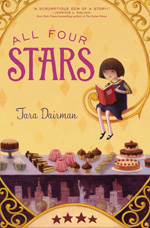 Absolutely delicious storytelling! Dairman’s debut novel contains all of the ingredients to tantalize readers. Gladys Gatsby has a deep appreciation for delectable cuisine. She’s only eleven, but her interest in food, recipes, and cooking reflects her dream of becoming a well-known food critic for a New York City newspaper. She maintains a food review journal and visits the local gourmet grocer for new flavors to use in her recipes. Unfortunately, after a kitchen mishap, she was no longer allowed to cook. Without cooking to occupy her free time, Gladys befriends her neighbor Sandy. His mother, Mrs. Anderson, loves to bake and when she lets Gladys hold the impressive original French cookbook, The Larousee Gastronomique, she is immediately overwhelmed with excitement. When her new teacher challenges the class to submit an essay about their hopes for the future, Gladys’ creativity soars. With her teacher’s encouragement, she finds her voice and trusts her passion to submit the winning essay for her class. Through a series of events, her essay for the New York standard $500 prize money was accidentally mistaken for an employment letter of interest. An email from the chief editor of the New York Standard’s Dining Section initiates an entirely creative and delectable plan. Gladys must find a way to get to “Classy Cakes” in Manhattan to complete her freelance review assignment. This is a delightful novel full of lively characters, beautiful language, humor, and creativity.
Absolutely delicious storytelling! Dairman’s debut novel contains all of the ingredients to tantalize readers. Gladys Gatsby has a deep appreciation for delectable cuisine. She’s only eleven, but her interest in food, recipes, and cooking reflects her dream of becoming a well-known food critic for a New York City newspaper. She maintains a food review journal and visits the local gourmet grocer for new flavors to use in her recipes. Unfortunately, after a kitchen mishap, she was no longer allowed to cook. Without cooking to occupy her free time, Gladys befriends her neighbor Sandy. His mother, Mrs. Anderson, loves to bake and when she lets Gladys hold the impressive original French cookbook, The Larousee Gastronomique, she is immediately overwhelmed with excitement. When her new teacher challenges the class to submit an essay about their hopes for the future, Gladys’ creativity soars. With her teacher’s encouragement, she finds her voice and trusts her passion to submit the winning essay for her class. Through a series of events, her essay for the New York standard $500 prize money was accidentally mistaken for an employment letter of interest. An email from the chief editor of the New York Standard’s Dining Section initiates an entirely creative and delectable plan. Gladys must find a way to get to “Classy Cakes” in Manhattan to complete her freelance review assignment. This is a delightful novel full of lively characters, beautiful language, humor, and creativity.
—Mary Napoli, Penn State Harrisburg
Grades 6-8
Woodson, Jacqueline. (2014) Brown Girl Dreaming. New York, NY: Nancy Paulsen Books.
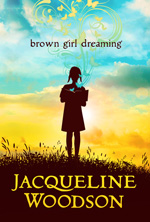 Woodson’s memoir is a testament to the power of family connections, hope in the face of tragedy, and the liberating force of writing. The book is divided into five parts and told through a series of poems. The poems capture moments in time as well as reflections on important stories. Some are quite short, some contain dialogue, and many will stand on their own. Woodsons does a beautiful job of rendering dynamic characters through brief descriptions. Readers may be left wondering about certain actions or endings, but the narrator’s affection for and understanding of her family (and friends) results in a satisfying level of intimacy. In addition, this collection provides a thoughtful balance of the personal and the political as African-American history is invoked across several states and within a range of years.
Woodson’s memoir is a testament to the power of family connections, hope in the face of tragedy, and the liberating force of writing. The book is divided into five parts and told through a series of poems. The poems capture moments in time as well as reflections on important stories. Some are quite short, some contain dialogue, and many will stand on their own. Woodsons does a beautiful job of rendering dynamic characters through brief descriptions. Readers may be left wondering about certain actions or endings, but the narrator’s affection for and understanding of her family (and friends) results in a satisfying level of intimacy. In addition, this collection provides a thoughtful balance of the personal and the political as African-American history is invoked across several states and within a range of years.
—Lesley Colabucci, Millersville University of Pennsylvania.
Wiles, Deborah. (2014). Revolution. New York, NY: Scholastic Press.
 Book two in Wiles’ ‘60s trilogy opens with a Langston Hughes poem, printed in white type against a black background. This sets the tone for the unique genre-blurring book. Revolution uses multiple voices as several characters experience Freedom Summer from different perspectives, including a white girl named Sunny and a black boy named Ray who both sneak into a pool at night for different reasons. These varied narrators powerfully show how one’s experience of history is shaped by race in both obvious and subtle ways. This historical fiction exploration of how the summer “invaders” came to Greenwood, MI, is balanced by pages of documentary elements such as archival photographs, newspaper clippings, and quotes from pamphlets, fliers, speeches, and songs. Wiles provides more than 30 pages of back matter to complement the extensive research that shines through in this books.
Book two in Wiles’ ‘60s trilogy opens with a Langston Hughes poem, printed in white type against a black background. This sets the tone for the unique genre-blurring book. Revolution uses multiple voices as several characters experience Freedom Summer from different perspectives, including a white girl named Sunny and a black boy named Ray who both sneak into a pool at night for different reasons. These varied narrators powerfully show how one’s experience of history is shaped by race in both obvious and subtle ways. This historical fiction exploration of how the summer “invaders” came to Greenwood, MI, is balanced by pages of documentary elements such as archival photographs, newspaper clippings, and quotes from pamphlets, fliers, speeches, and songs. Wiles provides more than 30 pages of back matter to complement the extensive research that shines through in this books.
—Lesley Colabucci, Millersville University of Pennsylvania
Grades 9-12
DeWoskin, Rachel. (2014). Blind. New York, NY: Viking.
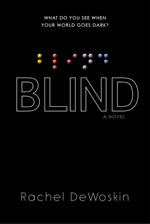 When Emma and her family were watching the fireworks display, one of the rockets backfired and hit the crowd. Emma felt a burning sensation that left her blind. Throughout this descriptive and emotional novel, Emma learns how to read braille and to walk with a cane. The year spent at the Briarly School for the Blind is described in great detail and Emma’s inner resolve and resiliency prove to serve her well as she returns to her regular high school. The subplot of Claire Montgomery’s apparent suicide is interwoven throughout the novel, with Emma and her friends creating a support group to talk about life, death, and their fears. Like her friends, Emma is coping with the death of her classmate in her own way. She discovers an inner strength that helps her to overcome her own limitations and challenges. Her friendships are tested, but also evolve as she cycles through new understandings about others and about herself. This novel moves beyond how one copes with a disability; it provides a powerful examination into the world of teens and their relationships.
When Emma and her family were watching the fireworks display, one of the rockets backfired and hit the crowd. Emma felt a burning sensation that left her blind. Throughout this descriptive and emotional novel, Emma learns how to read braille and to walk with a cane. The year spent at the Briarly School for the Blind is described in great detail and Emma’s inner resolve and resiliency prove to serve her well as she returns to her regular high school. The subplot of Claire Montgomery’s apparent suicide is interwoven throughout the novel, with Emma and her friends creating a support group to talk about life, death, and their fears. Like her friends, Emma is coping with the death of her classmate in her own way. She discovers an inner strength that helps her to overcome her own limitations and challenges. Her friendships are tested, but also evolve as she cycles through new understandings about others and about herself. This novel moves beyond how one copes with a disability; it provides a powerful examination into the world of teens and their relationships.
—Mary Napoli, Penn State Harrisburg
Sidman, Joyce. (2013). What the Heart Knows: Chants, Charms, & Blessings. Illus by Pamela Zagarenski. Boston, MA: Houghton Mifflin Books for Children.
 This collection of poems is divided into four sections with distinct purposes. Chants and charms aim to “bolster courage” and feature poems to invite sleep or happiness. Spells and invocations are designed to make things, like sandcastles and invisibility, happen. Laments and remembrances include reflections on regret and grief, both specific (a teddy bear) and general (“my old life”). Finally, the praise songs and blessings offer inspiration for showing love and gratitude. The accompanying illustrations have a dream-like quality that matches the overall tone of the collection. Students who may be inspired to write their own poems in spirit of these will find the definitions of the forms provided in the beginning of each section. This is a book for poetry lovers, writers, and dreamers of all sorts.
This collection of poems is divided into four sections with distinct purposes. Chants and charms aim to “bolster courage” and feature poems to invite sleep or happiness. Spells and invocations are designed to make things, like sandcastles and invisibility, happen. Laments and remembrances include reflections on regret and grief, both specific (a teddy bear) and general (“my old life”). Finally, the praise songs and blessings offer inspiration for showing love and gratitude. The accompanying illustrations have a dream-like quality that matches the overall tone of the collection. Students who may be inspired to write their own poems in spirit of these will find the definitions of the forms provided in the beginning of each section. This is a book for poetry lovers, writers, and dreamers of all sorts.
—Lesley Colabucci, Millersville University of Pennsylvania
These reviews are submitted by members of the International Reading Association's Children's Literature and Reading Special Interest Group (CL/R SIG) and are published weekly on Reading Today Online.